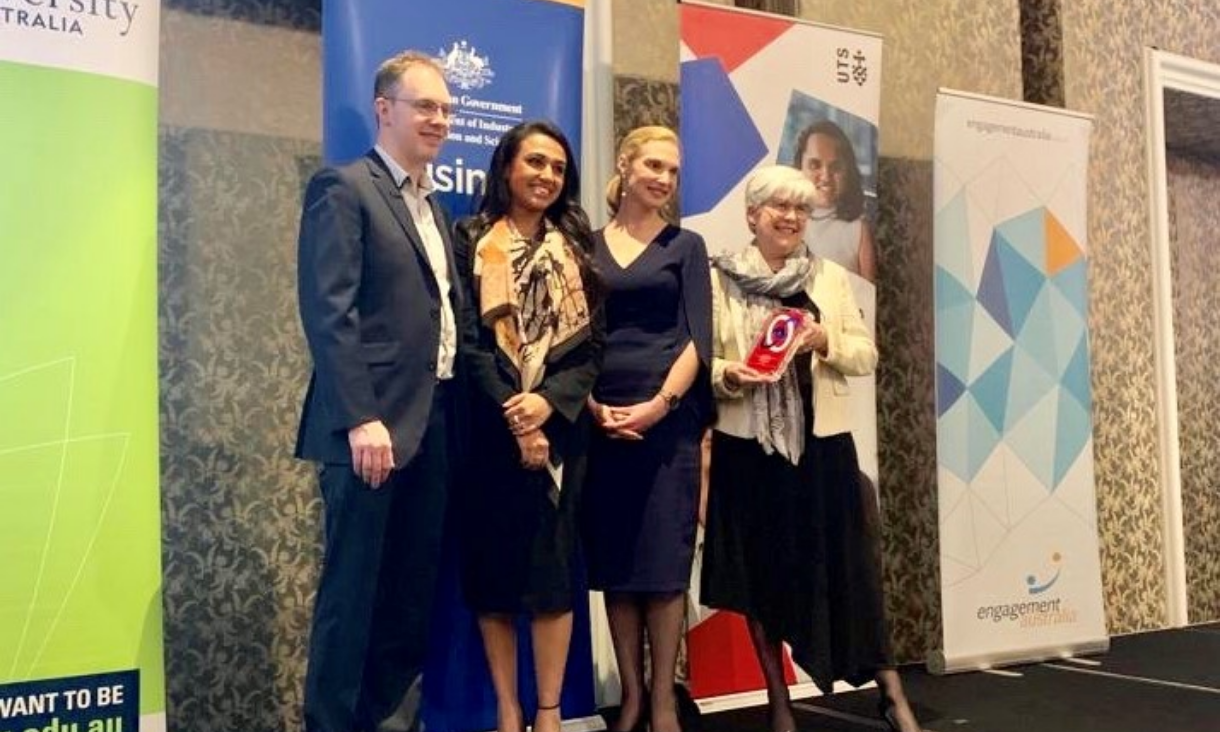 Accepting the Digital Transformation Award (L-R) General Manager, Tigerspike, Mark Boulton, RMIT Online Strategic Industry Partnerships Manager. Sanjoli Chauhan, RMIT Principal Advisor to DVCE and 21CC Project Lead, Dr Darien Rossiter
Accepting the Digital Transformation Award (L-R) General Manager, Tigerspike, Mark Boulton, RMIT Online Strategic Industry Partnerships Manager. Sanjoli Chauhan, RMIT Principal Advisor to DVCE and 21CC Project Lead, Dr Darien Rossiter
RMIT has taken out two categories in the prestigious Business / Higher Education Round Table (BHERT) Awards.
Since 1998, the Awards have recognised the importance of business-university partnerships in innovation, research and development, and teaching.
RMIT's Digital Credentials program won the Outstanding Collaboration in Higher Education and Training category, while the RMIT ABC Fact Check unit took out the Outstanding Collaboration for National (non-economic) Benefit award at a ceremony in Brisbane last night.
 Accepting the Digital Transformation Award (L-R) General Manager, Tigerspike, Mark Boulton, RMIT Online Strategic Industry Partnerships Manager. Sanjoli Chauhan, RMIT Principal Advisor to DVCE and 21CC Project Lead, Dr Darien Rossiter
Accepting the Digital Transformation Award (L-R) General Manager, Tigerspike, Mark Boulton, RMIT Online Strategic Industry Partnerships Manager. Sanjoli Chauhan, RMIT Principal Advisor to DVCE and 21CC Project Lead, Dr Darien Rossiter
Digital credentials leadership
While industry collaboration has always been part of RMIT's DNA, the University recognised that imaginative and impactful responses were needed to ensure graduates had the enterprise and digital skills essential for the future world of work.
The Digital Credentials program was developed in conjunction with industry partners including REA Group, Tigerspike, Credly and EY. It consists of RMIT Creds, a pioneering micro-credential program for students launched in 2017, and the RMIT Online Future Skills portfolio launched in 2018.
Students currently have their pick of almost 90 creds, which have been specifically designed to develop the soft - or human - skills employers are seeking and can be stacked on completion. Creds focused on cultural competency and emotional intelligence are among the most popular.
The Future Skills portfolio has seen the creation of almost 30 short online courses in collaboration with more than 50 industry partners including Accenture, AWS Educate, Adobe and Salesforce.
BHERT CEO Dr Peter Binks said the panel was impressed with the range and quality of RMIT products, and the University's collaborations to meet industry skill development needs.
"RMIT University has established a leadership position in Australia in the rapidly growing field of digital learning," Binks said.
"Its strategic partnership with Credly, a leading global digital credentialing platform, and the development of 85 industry relationships to inform the design and delivery of their credentials, made this a standout program."
Deputy Vice-Chancellor Education and Vice-President Professor Belinda Tynan said the University was proud to give its students the confidence, knowledge, skills and connections they need to succeed as industry-ready, lifelong learners in an ever-changing world.
"As industry demands new and rapidly evolving skills; as digitalisation and automation create new challenges and opportunities, we understand how to shift, adapt, evolve and respond," she said.
"Central to this is our focus on technology, which has been part of our identity for more than 130 years.
"Our flexible approach and industry connections continue to help educate our students for the jobs that exist today, prepare for jobs that may not exist yet and adapt in a world where change is a constant."
RMIT Online CEO Helen Souness said the award affirmed the team's work and vision of forging trailblazing industry partnerships to curate courses that were relevant for the future of work.
"We are so honoured to receive this year's award for Outstanding Collaboration in Higher Education and Training and to be recognised for our commitment to creating a community of lifelong learners that are equipped with relevant skills to succeed in Industry 4.0," she said.






